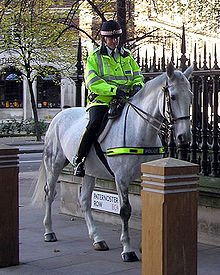Paternoster Row
Largely destroyed during aerial bombing in World War II, the street's area is now the site of much of Paternoster Square.The street is supposed to have received its name from the fact that, when the monks and clergy of St Paul's Cathedral went in procession chanting the great litany, they would recite the Lord's Prayer (Pater Noster being its opening line in Latin) in the litany along this part of the route.Occupied by sheet music publisher Fredrick Pitman, the first floor was found to be on fire by a police officer at 21:30.The street was devastated by aerial bombardment during the Blitz of World War II, suffering particularly heavy damage in the night raid of 29–30 December 1940, later characterised as the Second Great Fire of London, during which an estimated 5 million books were lost in the fires caused by tens of thousands of incendiary bombs.[15] After the raid a letter was written to The Times describing: '...a passage leading through "Simpkins" [which] has a mantle of stone which has survived the melancholy ruins around it.On this stone is the Latin inscription that seems to embody all that we are fighting for :- VERBUM DOMINI MANET IN AETERNUM' [The word of God remains forever].




City of London PoliceCity of LondonbooksellersSt Paul's ChurchyardPaternoster SquareWorld War IILondon Stock ExchangeSt Pauls tube stationNew ChangeCheapsideAve Maria LaneWarwick AvenueAmen CornerPaternoster LaneSt Paul's CathedralprocessionlitanyLord's Prayeropening linepaternoster beadsPater NosterSt. Paul's ChurchyardGreat Fire of Londonold St. Paul's CathedralSt. Paul's CathedralAldus ManutiusSamuel BagsterCharlotte BrontëAnne BrontëJane Eyresheet musicSt. Martin's-le-GrandTrübner & Cothe BlitzSecond Great Fire of LondonThe TimesLord QuickswoodWendell WillkieA General History of the PyratesPamelanumbersThe Tyger's HeadChristopher BarkerRobert BarkerThe StarHenry DenhamThe Brazen SerpentSamuel GellibrandThe Golden Ball/BallThe GunThe BellThe SunThe AngelMoses PittThe BearThe Rose and CrownThe CraneThe PeacockThe Three PigeonsThe Golden Lyon/Golden LionThe Red Lyon/Red LionThe Phoenix/PhœnixThe Three Flower-de-luces/Three Flower-de-LucesThe Bishopshead/Bishops Head/Bishops headThe Princes Arms/Prince's Arms (Arms of the Prince of Wales)Samuel SmithBenjamin WalfordRoyal SocietyThe GlobeThe ShipJohn TaylorWilliam TaylorLongmansThe Black SwanAwnsham ChurchillCharles RivingtonRivington (publishers)The CrownOxford University PressTrubner and Co.Samuel Bagster and SonsGeorge RobinsonIvy LaneUpper Gower StreetHodder & StoughtonSheed & WardHurst and BlackettBlackwood and SonsLongman, Hust, Rees, Orme, Brown and GreenLongman and Co.Longmans, Green, and Co.ChambersThe Religious Tract SocietyThe Sunday School UnionSampson LowThomas NelsonBoys BrigadePaternoster GangDoctor WhoVictoriaQueen VictoriaJenna ColemanHistory of LondonDoctors' CommonsFleet StreetPaul's walkSt. Paul's CrossReligious Tract SocietyRaven, JamesYale University PressThornbury, WalterWard, Lock & Company, LimitedNotes and QueriesPayne, WilliamRichard BurroughJohn BakerSun and MoonRoyal ExchangeCornhillSt. Paul's Church-YardStephen, LeslieDictionary of National BiographyGlasse, HannahWilson, MariaLongman, Brown, Green and LongmansFeltham, John